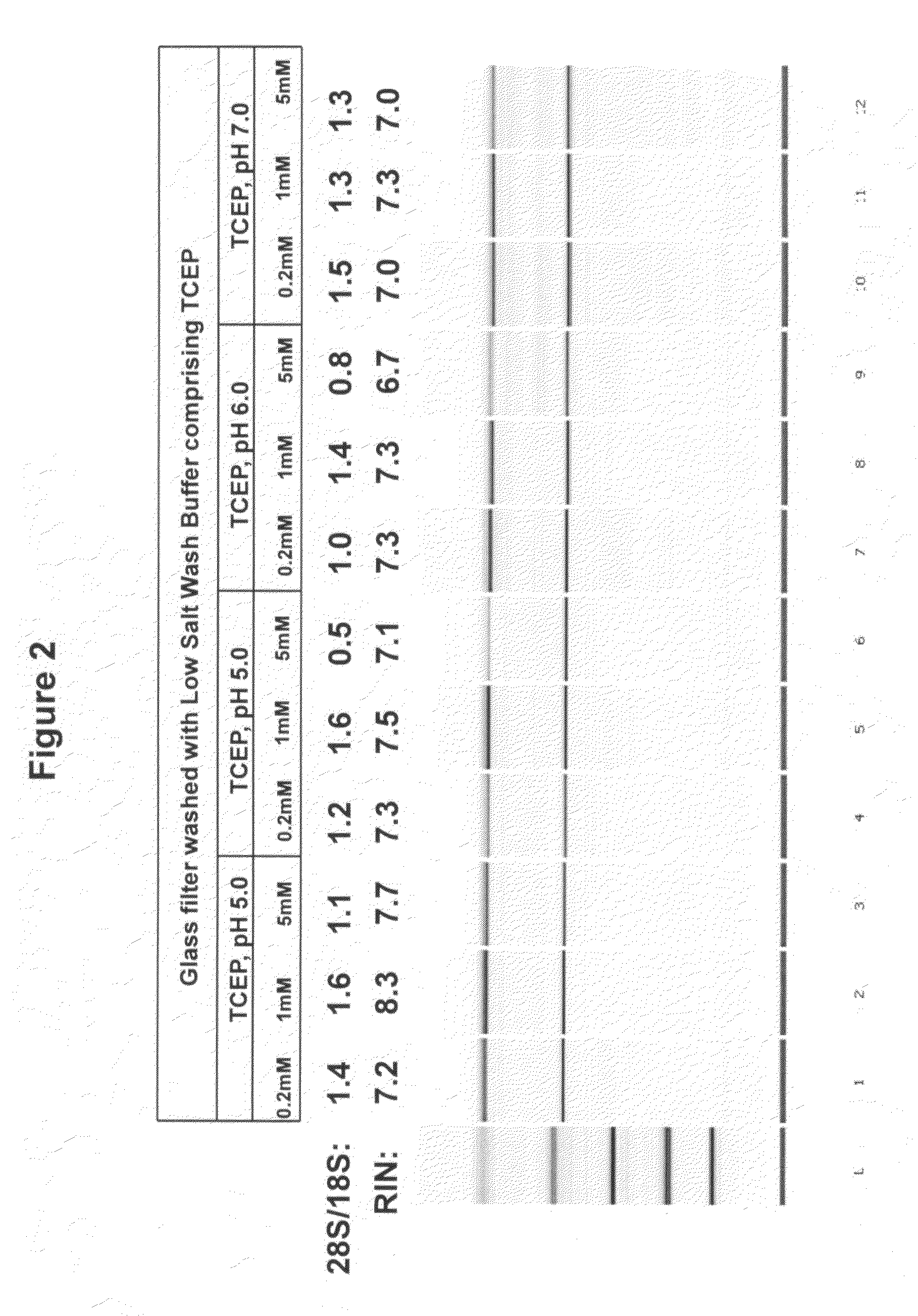Stabilization of nucleic acids on solid supports
a technology of solid supports and nucleic acids, applied in the field of biological molecules storage, to achieve the effect of excellent quality and better characterizing the effect of tcep on rna stability
- Summary
- Abstract
- Description
- Claims
- Application Information
AI Technical Summary
Benefits of technology
Problems solved by technology
Method used
Image
Examples
example 1
Effect of TCEP on Jurkat RNA Stability on Glass-Fiber Filter
[0047]In general, RNA was isolated from a Jurkat cell line or human white blood cells using the following protocol for all the experiments in the Examples. The cells (1×107) were collected on glass-fiber spin cups in 50 ml tubes. The cells were washed with 10 ml and then 5 ml of PBS buffer (GIBCO formulation) to reduce contaminants. The filter was transferred to fresh tubes and 3 ml of Lysis Buffer (5 M guanidine thiocyanate, 20 mM sodium citrate pH 7.0, 0.05% sarcosyl, 1% Triton X-100, 0.01% Anti-foam A, 5 mM TCEP pH 5.0) was passed through the filter resulting in the release of nucleic acids from the cells. Genomic DNA was adsorbed to the glass fiber filter in the lysis step. The filtrate, comprising mainly RNA, was measured, an equal volume of 80% sulfolane was added to the filtrate, and aliquots of the filtrate (about 500 ul) comprising the sulfolane were passed through glass-fiber spin cups in 1.5 ml microcentrifuge tu...
example 2
Effect of Tris on RNA Stability in Wash Buffers Containing TCEP
[0052]To test the effect of Tris on RNA stability, RNA samples from Jurkat cells were processed essentially as described above, with the exception that, in some cases, Tris was not added to the LSW. Characteristics of the resulting RNA are shown in FIG. 4. In summary, RNA isolated using a wash buffer containing 1 mM TCEP, pH 5.0, without Tris showed improved RNA stability after 3 days at 37° C., as compared to use of a buffer with 2 mM Tris. That is, the Jurkat RNA isolated and stored using TCEP buffer without Tris showed an RIN of 8.1 and 8.0, and a 28S / 18S ratio of 1.8 and 1.9. In contrast, Jurkat RNA isolated and stored using TCEP buffer that included Tris at 2 mM showed an RIN number of 7.3 and 8.2 and a 28S / 18S ratio of 1.2 and 1.5. Thus, under these conditions, using wash buffer that includes TCEP but lacks Tris can be advantageous.
example 3
Analysis of TCEP Concentration on RNA Stability in the Absence of Tris
[0053]Having established the beneficial effects of TCEP on RNA stability and the deleterious effect of a combination of TCEP and Tris, as compared to TCEP alone, the effect of different concentrations of TCEP on RNA stability, in the absence of Tris, was examined. To do this, RNA from Jurkat cells was isolated as described above, using LSW buffers containing TCEP, pH 6.0, but lacking Tris. The concentration of TCEP in the LSW buffers was varied from 5 mM to 0.037 mM. Buffer lacking both Tris and TCEP was also used. Samples were isolated and stored on glass fiber filters for 3 days at 37° C. The results are shown in FIG. 5. As can be seen from the figure, all samples isolated using buffers containing TCEP, pH 6.0, at the tested ranges showed acceptable stability, whereas samples isolated without TCEP were less stable. The use of anywhere from 0.037 mM TCEP to 5 mM TCEP, pH 6, provided an improvement to RNA stabilit...
PUM
| Property | Measurement | Unit |
|---|---|---|
| time | aaaaa | aaaaa |
| temperatures | aaaaa | aaaaa |
| temperature | aaaaa | aaaaa |
Abstract
Description
Claims
Application Information
 Login to View More
Login to View More - R&D
- Intellectual Property
- Life Sciences
- Materials
- Tech Scout
- Unparalleled Data Quality
- Higher Quality Content
- 60% Fewer Hallucinations
Browse by: Latest US Patents, China's latest patents, Technical Efficacy Thesaurus, Application Domain, Technology Topic, Popular Technical Reports.
© 2025 PatSnap. All rights reserved.Legal|Privacy policy|Modern Slavery Act Transparency Statement|Sitemap|About US| Contact US: help@patsnap.com



